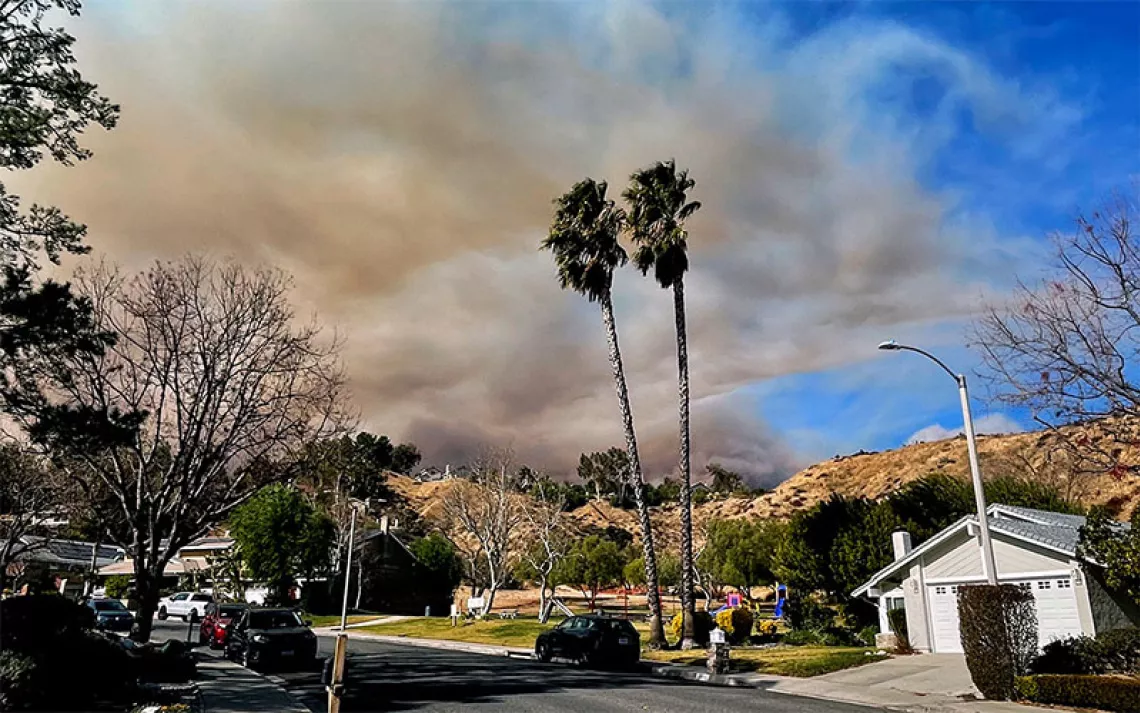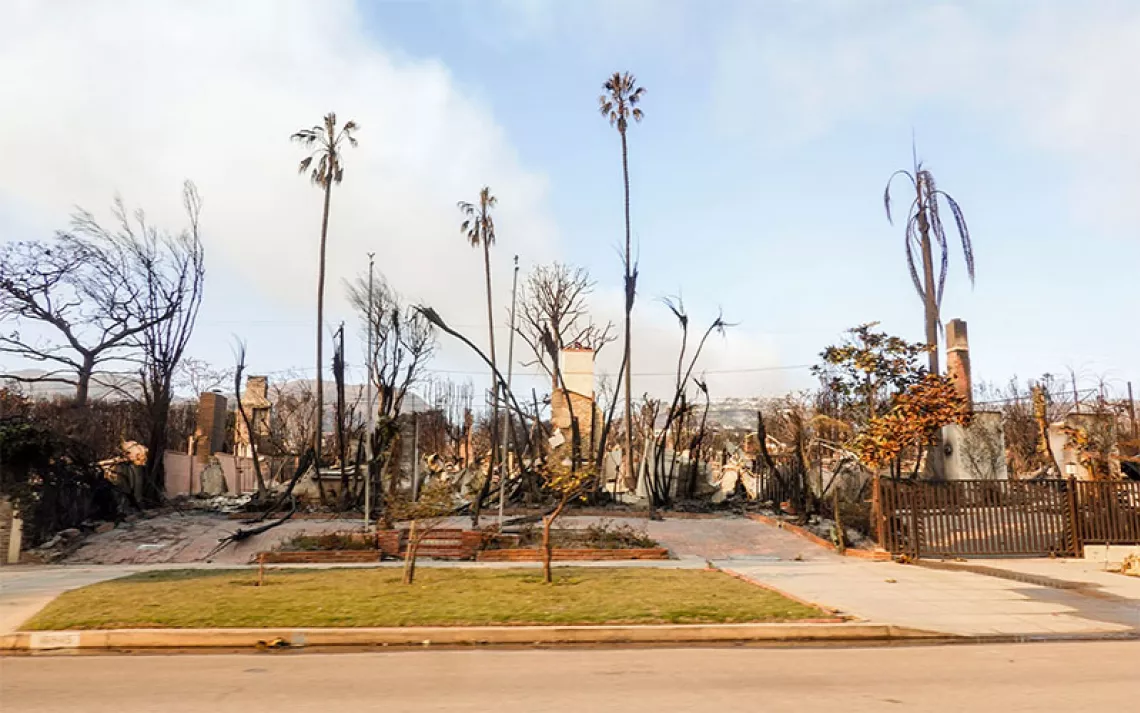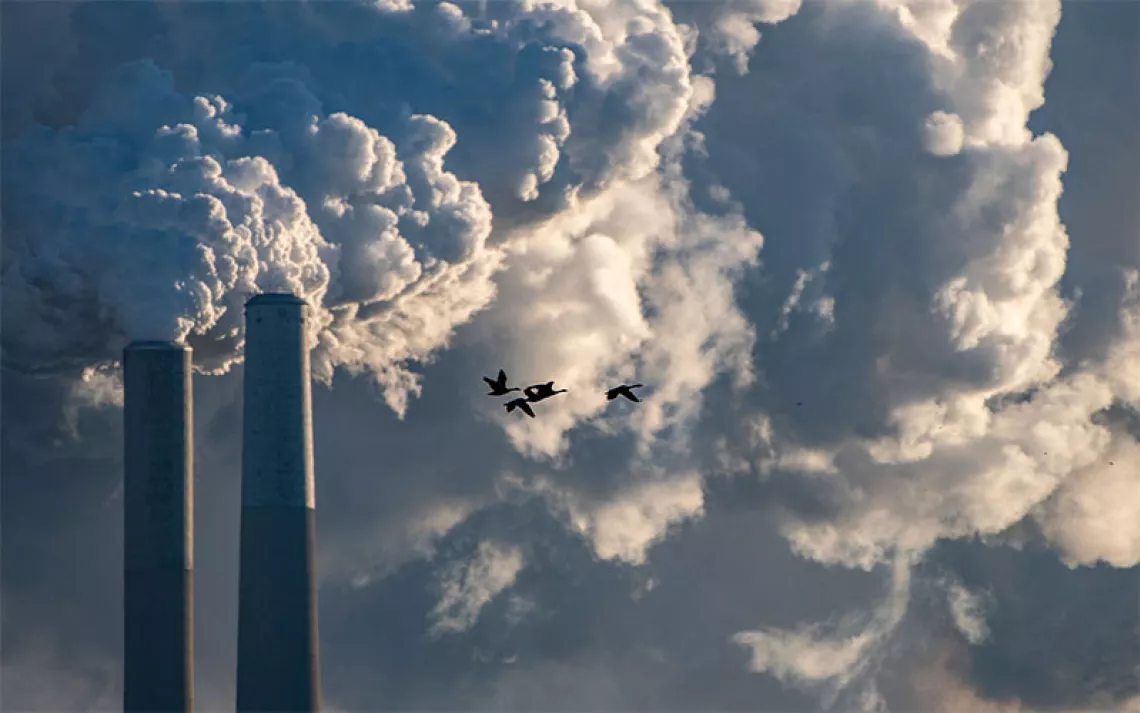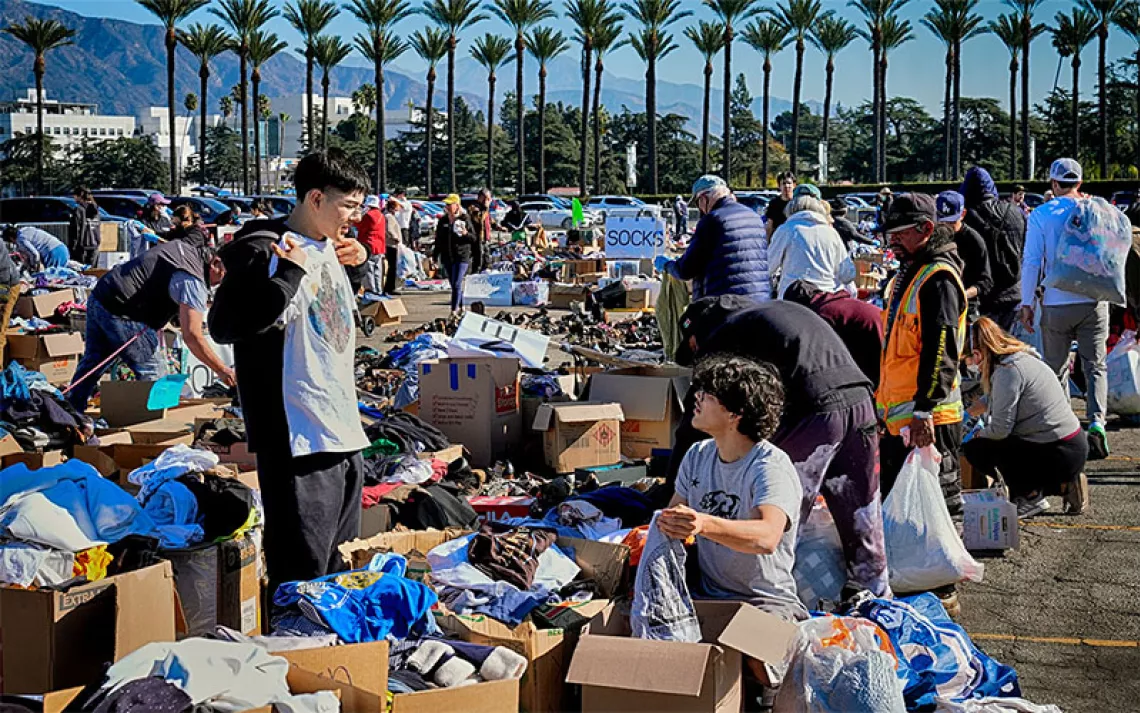Can Phoenix Remain Habitable?
You can't crank up the AC forever

Illustrations by Cate Andrews
ROUGHLY EVERY 45 MINUTES, someone calls the Maricopa County Office of the Medical Examiner to report a death. Tucked into an unremarkable taupe stucco building at the edge of downtown Phoenix, the office investigates the cause of death for traffic-accident victims, suspected homicides, and any fatality that stands out as unusual in some way. That's about one out of five of the 30,000 people who die each year in the Valley of the Sun.
In the summer, the calls come more frequently and so do the bodies—as many as 220 in a single week are stacked on metal shelves in giant coolers on the building's bottom floor. As the mercury climbs, the death rate increases in this sprawling metropolis of 4.5 million souls—and so, too, does the urgency with which callers feel the need to get the deceased into one of those freezers.
Take, for instance, the body of Charles Allan Rhodes, a 61-year-old man whose decomposing corpse was found in 2016 after his mail started piling up and neighbors called the cops. An investigator noted that Rhodes's air conditioner was broken and that his death had occurred "during a period of markedly elevated environmental temperatures."
Maricopa County medical investigators are trained to look for such things: a broken AC, an unpaid water bill, a lack of housing, a hot room, hot car, or hot yard. The body itself doesn't reveal as much as the surroundings and circumstances. A test of fluid in the eye can tell a forensic pathologist whether the person was dehydrated, but sometimes, as in Rhodes's case, the body is too decomposed to be useful. So investigators ask questions, making calls from a warren of cubicles on the office's second floor, trying to tease out, among other things, the role that temperature played in the last moments of someone's life.
"When the temperatures start to rise, it's always in the forefront of our minds that we might be dealing with a heat-related death," chief medical examiner Jeff Johnston explains. Because heat kills. And in Maricopa County, the medical examiner's office has spent the past 12 years tracking who it kills, where it kills, and how it kills.
In 2017, more than 172 people died from heat-related causes in the county, a 9,000-square-mile region that contains 60 percent of Arizona's population. For each of these deaths, the Public Health Department can tell you the place of injury, the person's age, and whether they had access to air conditioning. It can tell you that men are more likely to die outdoors and women are more likely to die indoors, and that nearly a third of the people who died were between the ages of 50 and 64. And it can tell you that heat-related deaths are increasing, having jumped by 82 percent between 2015 and 2017.
This meticulous record keeping has a purpose: to help public health officials learn how to keep people alive in a warming climate. The Arizona desert has been hot for a long time, but 2017 was the hottest year in Maricopa County's recorded history. Over the past three decades, heat has caused more U.S. deaths than any other weather-related hazard, including blizzards, floods, hurricanes, and tornadoes. Researchers expect U.S. heat deaths to reach into the thousands or tens of thousands by the end of the century.

That makes the work of the medical examiner's office significant not just for Arizona but for any place that gets hot. "Essentially we're taking biopsies of society," Johnston says.
Nationwide, according to the Centers for Disease Control and Prevention, there are roughly 600 heat-related deaths each year, a quarter of which occur in Arizona. These numbers reflect the fact that Arizona does a much better job of tracking heat-related deaths than other states, but Arizona also has a lot of people living in a very unforgiving climate. The fifth-largest city in the country, Phoenix is also one of the fastest growing. One and a half million people live within the Phoenix city limits, but sprawl has created a metro area that encompasses 14,500 square miles and two counties. Every year, thousands of people move to the area, despite the fact that for a third of the year temperatures reach 100°F or higher, with three or four weeks of temperatures above 110°.
Phoenix boosters tend to downplay the heat, bragging instead about the "highly skilled labor force, low operating costs, and low risk of natural disasters." One website explains, "There are no tornadoes or hurricanes in Phoenix— only the occasional haboob dust storm, which is sort of a gust of dusty wind that deposits dirt on your car once a year."
As it happened, a haboob hit Phoenix on the July afternoon that I arrived, the second one of the week and one of the largest in living memory. A mile-high column of brown dust swept into the city from the northeast and then dissolved into a sky-darkening haze when it collided with the hotter temperatures of the urban core. I'd gotten an alert on my phone warning me about hazardous driving conditions. A subsequent alert warned that the dust particles were a health hazard, so I should do my best not to breathe. Shortly after the haboob, a thundering monsoon drenched the city, the dust-speckled sky fading from brown to black and then unleashing a torrent of rain that flooded streets and parking lots and knocked out power all over town. For the next few days, Phoenix stayed just below 100°; people I interviewed kept apologizing for the fact that the temperature was so mild when I had come to town to report on extremes.
It still seemed plenty hot. Over the past century, the hot season in Phoenix has extended almost three weeks in each direction, while overnight temperatures, which used to provide a respite from the daytime heat, have increased by as much as 12°. Researchers expect these trends to continue as Phoenix grows, because adding more heat-retaining pavement and structures—plus more heat-producing people and machines—contributes to the "urban heat island effect," which makes the city hotter than the surrounding desert.
"I don't think we can rule out 130° in Phoenix in the future," says David Hondula, an Arizona State University professor who studies the health effects of extreme heat. A 2016 report by Climate Central predicts that by 2050, Phoenix will be among 25 U.S. cities in which heat poses a danger to human health for more than half the year.
MARK HARTMAN, Phoenix's chief sustainability officer, started his career in Vancouver, B.C., and admits that he had doubts about coming to Phoenix. "I had a pretty strong bias, like, 'They're going to run out of water in probably a year,'" he says. But he's since changed his tune.
"Adversity is the midwife of resilience," he asserts. "I would say that for extreme heat, Phoenix is actually at less of a risk because basically it's an entirely air-conditioned city."
If there's a trace of defensiveness in Hartman's voice, it's understandable. The desert metropolis has been called "the world's least sustainable city," and articles predicting Phoenix's impending doom appear regularly. The Cassandras often focus on water—the city gets only 7.5 inches of rain a year, and its water supply depends on flows from the Colorado, Salt, and Verde Rivers. But a 19-year drought has reduced the Colorado to a trickle and hollowed out both Lake Mead and the Salt and Verde Rivers' reservoirs. Civic optimists remain confident that water will continue to flow into the city's taps, toilets, and swimming pools, citing long-standing efforts to bank water in underground aquifers and the fact that Phoenicians are gradually becoming less wasteful—the average resident in 2014 used 29 percent less water than in 1990. They argue, too, that the heat that keeps people in air-conditioned homes is no more extreme than the cold that keeps people huddled indoors during a Chicago winter.
But questions about the future remain. Even with the latest Intergovernmental Panel on Climate Change report warning of catastrophic impacts within the next 20 years, there is little engagement among Phoenix officials with the notion that the city's future habitability might depend on a more extensive adaptive response than cranking up the AC.
"I don't know if Phoenix is the least sustainable city or not, but there are legitimate questions about our lifestyle here," says Sandy Bahr, director of the Sierra Club's Grand Canyon Chapter. "And if you ask 'sustainable for whom?' . . . well, it's always those with resources who are going to be able to jack up their air conditioning and pay those higher bills."
Twenty-two percent of Phoenix residents live in poverty, and at any given point about 6,300 are homeless. These are the people who fall into what social scientists call the "climate vulnerability gap." The divide is starkly obvious as you drive from one end of the city to another. The city's richer, northern neighborhoods are lush oases of green lawns and shady trees; the impoverished southern neighborhoods, mostly populated by people of color, are block after block of barren, baking streets, mini-malls, vacant lots, and gravel or dirt front yards. The disparity in vegetation causes a summertime temperature differential that can be as high as 10 degrees. An Arizona State University study found that for every $10,000 increase in a neighborhood's average household income, the local temperature sinks half a degree. For the poor, it's a catch-22. Lack of shade increases the cost of air conditioning, but planting trees increases the cost of water.
"Green areas we don't have in my neighborhood," explains Cecilia Laguna, an activist with the Arizona branch of Chispa, a Latino organizing project of the League of Conservation Voters, speaking through a translator. "But we do have body shops, junk shops, gas stations, industrial parks, cement—and schools in the middle of this."
Laguna's summer power bills sometimes climb to $600 a month, far more than she can afford to pay. "When we are behind $200, they just cut it off," she says.
In a Maricopa County assessment, a quarter of the county's population said that the cost of electricity is a barrier to keeping their homes properly cooled, and 10 percent feel hot inside their homes most or all of the time. That situation has been exacerbated by a recent rate hike from Arizona Public Service, the state's largest utility; customers complain that they have to choose between air conditioning and food. (APS's parent company, Pinnacle West Capital, spent about $11 million unsuccessfully trying to keep a measure that would require sun-drenched Arizona to get half its power from renewables by 2030 off the November 2018 ballot. APS then spent another $30 million to defeat it.)
I meet Laguna at the Chispa office, a low-slung converted house cooled by a ceiling fan, its walls decorated with posters supporting climate science and undocumented students. She's joined by several other activists and organizers, including Herlinda Calderon, whose 11-year-old daughter, Oselen, is only allowed to go outside for 10 minutes at a time during the summer because the heat triggers asthma attacks.
"She wants to be outside," Calderon says, also speaking through a translator. "But if we allow her to go out, we know we're going to have a long night." In the evenings, Calderon allows Oselen to go outside and ride her bike—but only if she covers her face with a painter's mask to keep from inhaling particulates.
Calderon, a 15-year Phoenix resident, has a round face and blond-streaked brown hair that she wears pulled back in a ponytail. She's funny and extroverted, and laughs easily. But her stories have a dark edge. A few weeks earlier, her car broke down at two in the afternoon. She and her five-year-old daughter, Kimberly, set out to walk the short distance home. "I thought, 'It's just a mile. We can make it,'" she recalls. But it was 110°, and there were no trees and no shade. Kimberly's face turned red, and the hot pavement melted the soles of Calderon's sandals and blistered the skin on her feet. Her lips began to swell, and she could feel her heart pumping and fluttering. Luckily, a friend happened to drive by, saw Calderon without shoes and Kimberly looking weak and ill, and gave them a lift. Weeks afterward, Calderon's heart still fluttered, but, she says, "I don't go to the doctor because each visit costs $50, and I can't afford it."
This makes Calderon part of an important but undercounted demographic—those whose health is affected by the heat but who don't seek care. Such nonreporting makes it difficult to calculate the full public health impacts of rising temperatures, says Arizona State's Hondula. If a construction worker becomes disoriented on a 110° day and falls off a ladder, he says, that injury is absolutely heat related but wouldn't necessarily be classified as such: "We don't know how many people were feeling light-headed and didn't call their doctor. We don't know how many people suffered an accident at the workplace because they were feeling fatigued."
Among those who do seek care, a study by Hondula found, for every heat-related death in Maricopa County there are 10 heat-related hospitalizations and 40 heat-related emergency room visits. Surveys have shown that 25 to 35 percent of residents have experienced negative health impacts from the heat.
"That's a million people," Hondula says. "Which is a lot of people by any measure."
NOT LONG AFTER TALKING WITH CALDERON, I stop in at Phoenix Fire Station 18, where 10 firefighters sit watching Croatia beat England in the World Cup over a lunch of sliders and tater tots. Heat-related calls are a daily occurrence, they say, regaling me with stories about people succumbing to heat in nearly every imaginable circumstance—at a car show, at a teachers' march, at the light-rail station where the homeless go to get out of the sun. On one memorable day last summer, they say, more than half the calls in a 10-hour shift were heat related.
Many of those calls were routine—people just needed water, shade, or treatment for blistered feet. But sometimes it's much worse. Heatstroke means that a body can no longer regulate its temperature, which can shoot above 106° within 10 or 15 minutes. That's when firefighters break out the IV fluids and ice packs in a frantic attempt to bring down the victim's core temperature.
"If somebody's messed up from the heat, it's really easy to identify it," Captain Tim West explains. "We can almost tell walking up—this person needs to go to the hospital. They're pale and unconscious, and there's no sweat, and you touch them and they're super hot. You know they're in deep trouble."
They had a call just that morning about a woman who was on the verge of that danger zone. She'd been overcome by the heat while on a walk and stumbled into an apartment complex acting disoriented. "She was bone-dry, super confused," Captain Kevin Duzy recalls. "She didn't know where she was or her address."
Worse yet is when a person who's fainted is badly burned by the pavement they landed on. "Remember that call?" one of the firefighters says to the others. "This one guy had a seizure, and he ended up with third-degree burns running down his entire back, and his temperature was like 108°. He ended up passing away."
IN 2018, HONDULA WAS PART OF a team working on a proposal for a Heat Ready program for the city. When they tried to figure out who should be thinking about the issue, "it was hard to identify departments that shouldn't be involved," he says.
Everything in the city is affected by the heat, and yet no one is directly charged with managing it. That means that even while Phoenix is mobilizing a response to the danger, initiatives that could help prevent temperatures from rising even higher sometimes fall through the cracks. Since 2010, for example, the city has had a goal of doubling the existing tree canopy, to shade a quarter of city streets by 2030, which an Arizona State University study found could reduce urban temperatures by more than 4°. Three thousand new trees were supposed to be planted in 2018.
But critics say that there is little enforcement or oversight and that existing trees are often neglected or removed. "The city has been horrible at requiring shade trees and street trees," the Sierra Club's Bahr says. "New developments have been allowed to go in with palm trees as the trees—these are not native, and they don't provide shade."
Other adaptation measures already in place are similarly plagued by a lack of enforcement. A 2006 construction code requires all new city buildings to have the white or reflective "cool roofs" that can cut the heat island effect by as much as half, but the regulation doesn't extend to the private sector. Eminently sensible approaches like shading parking lots with solar PV canopies are purely voluntary.
Sustainability chief Hartman remains convinced that Phoenix has the capacity to be a model of environmental adaptation and still grow at a rate of 1 or 2 percent each year. An avid urban cyclist, he wants to divide the city into 15 "vibrant urban villages" that would be conducive to walking and biking and where residents could get 80 percent of needed services without getting into a car. (The city has made a first step by adding 5,000 new downtown housing units in the past two years.) Hartman speaks of plans to increase the energy efficiency of residential buildings and to bring in bike paths and autonomous electric buses. "As humans, we grossly overestimate what we can do in a year," he says, "and grossly underestimate what we can do in 20."
Hartman's enthusiasm is infectious, but it wears off once I step outside. Phoenix remains a sprawling city of treeless, extra-wide, six- and eight-lane boulevards, where cars drive fast with the windows up and the AC on. (Arizona has the highest number of pedestrian deaths in the nation.) I drive to the top of South Mountain Park and look out at the vast Valley of the Sun, an endless plain of single-story buildings and parking lots occasionally interrupted by the green of a golf course. Every expert I spoke to dismissed the doom-and-gloom forecasts about the city's capacity to adapt, and yet each seemed troubled by the challenges ahead. What happens if there's a sustained power outage during a heat wave, leaving the city without air conditioning for days at a time? What happens if the drought continues for 50 or 100 years? What happens during a major recession when thousands of people suddenly can't pay their power bills? Things might be fine in Phoenix as long as they stay pretty much as they are now—but climate scientists warn us that big changes are coming, and not for the better. That's when the nightmare scenarios kick in.
True adaptation requires an honest assessment of the situation, realistic engagement with worst-case scenarios, and a sustained investment in solutions. To withstand the temperatures that are coming, the Phoenix region will need to aggressively confront its urban heat island impacts—by mandating changes in building, roofing, and pavement materials; by redesigning streets to drastically reduce the use of cars and the amount of paved surface; and by planting and maintaining drought-tolerant shade trees like paloverde and mesquite. The region needs to invest heavily in renewables, bikeways, and public transit, and to finally confront the uncomfortable reality that the desert metropolis cannot continue to grow indefinitely without endangering its own existence.
So far, Phoenix seems to be tinkering around the edges of the problem. It could adapt to the terrible summer that's coming, but time is running out.
This article appeared in the January/February 2019 edition with the headline "Summer Is Coming."
MORE
How a fast-food worker cooled down Denver: sc.org/green-roofs.
PHOENIX BY THE NUMBERS
In coping with its extreme summer heat, Phoenix faces today what other U.S. cities will experience in the next few decades. By that time, of course, Phoenix's temperatures will be even higher—130°F is possible.
2017
Hottest year in Maricopa County in recorded history
172
Number of people who died from heat-related causes in the county in 2017
600
Estimated number of annual heat-related deaths in the United States
6,300
Number of people in Phoenix who are homeless
10°
Temperature differential between Phoenix's richer, shady neighborhoods and its poorer, barren ones
-0.5°
Average decrease in a Phoenix neighborhood's temperature for every $10,000 increase in average household income
29
Percent by which people in Phoenix reduced their average annual water use between 1990 and 2014
10
Percent of Phoenicians who feel hot inside their homes most or all of the time
25 to 35
Percent of residents who say they've experienced negative health effects from Phoenix's heat
 The Magazine of The Sierra Club
The Magazine of The Sierra Club



